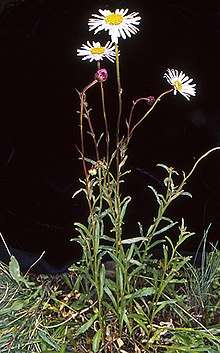Brachyscome aculeata
Brachyscome aculeata, commonly known as hill daisy is a tufted perennial herb in the family Asteraceae and is endemic to Australia. It has mostly white daisy-like flowers, a yellow centre, variable shaped leaves and flowers in spring to autumn.
| Hill daisy | |
|---|---|
 | |
| Scientific classification | |
| Kingdom: | |
| (unranked): | |
| (unranked): | |
| (unranked): | |
| Order: | |
| Family: | |
| Genus: | |
| Species: | B. aculeata |
| Binomial name | |
| Brachyscome aculeata | |
Description
Brachyscome aculeata is a herb with ascending branches, 20–60 cm (7.9–23.6 in) tall with leafy stems. The leaves may be either smooth or with hairs, lower leaves lance shaped, broader at the apex or narrow and rounded at the end, 2–9 cm (0.79–3.54 in) long, 5–15 mm (0.20–0.59 in) wide, usually with a straight edge but occasionally with teeth or lobes. The uppermost leaves are smooth edged, narrow to lance shaped. The flowers are white, rarely pink, daisy-like 4 cm (1.6 in) across with a central yellow disc. The 12-20 flower bracts are arranged in rows, egg-shaped to narrow lance shaped, 5–8 mm (0.20–0.31 in) long and 1.7–2.5 mm (0.067–0.098 in) wide, edges rounded or sharply pointed. The dry fruit are one-seeded, egg-shaped, 3–3.5 mm (0.12–0.14 in) long, 2.1–2.5 mm (0.083–0.098 in) wide, either smooth or a finely warty surface. Flowering occurs from October to April.[2][3][4]
Taxonomy and naming
The species was originally named Bellis aculeata in 1806 by Jacques Labillardière and the description published in Novae Hollandiae Plantarum Specimen.[5][6] In 1832 Christian Friedrich Lessing changed the name to Brachyscome aculeata and the description was published in Synopsis Generum Compositarum.[7][8] The specific epithet (aculeata) is derived from the Latin word aculeatus meaning "prickly" or "sharp-pointed".[9]
Distribution and habitat
In New South Wales hill daisy is found growing in dry locations in the southern tablelands from Wingello to Kosciuszko National Park. In Victoria mainly found in the east of the state growing in wet locations, in the Grampians region, also at higher altitudes but rarely into open herb fields.[2][4]
References
- "Brachyscome aculeata". Australian Plant Census. Retrieved 28 December 2019.
- Everett, J.; Murray, L. "Brachyscome aculeata". PlantNET-NSW Flora Online. Royal Botanic Gardens Sydney. Retrieved 29 December 2019.
- Sharp, Sarah; Rehwinkel, Rainer; Mallinson, Dave; Eddy, David (2015). Woodland Flora a field guide for the Southern Tableland (NSW & ACT). Canberr: Horizon Print Management. ISBN 978-0-9944958-0-8.
- "Brachyscome aculeata". VICFLORA-Flora of Victoria. Royal Botanic Gardens Victoria. Retrieved 29 December 2019.
- "Bellis aculeata". Australian Plant Name Index. Retrieved 29 December 2019.
- "Novae Hollandiae Plantarum Specimen". Biodiversity Heritage Library. Retrieved 29 December 2019.
- "Synopsis Generum Compositarum". Biodiversity Heritage Library. Retrieved 29 December 2019.
- "Brachyscome aculeata". Australian Plant Name Index. Retrieved 29 December 2019.
- Brown, Roland Wilbur (1956). The Composition of Scientific Words. Washington, D.C.: Smithsonian Institution Press. p. 553.